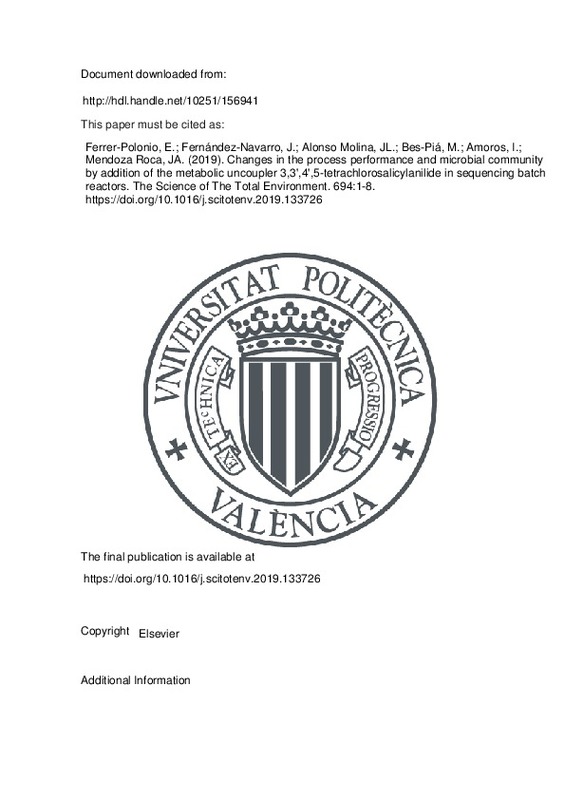JavaScript is disabled for your browser. Some features of this site may not work without it.
Buscar en RiuNet
Listar
Mi cuenta
Estadísticas
Ayuda RiuNet
Admin. UPV
Changes in the process performance and microbial community by addition of the metabolic uncoupler 3,3',4',5-tetrachlorosalicylanilide in sequencing batch reactors
Mostrar el registro sencillo del ítem
Ficheros en el ítem
| dc.contributor.author | Ferrer-Polonio, Eva
|
es_ES |
| dc.contributor.author | Fernández-Navarro, Julián
|
es_ES |
| dc.contributor.author | Alonso Molina, José Luís
|
es_ES |
| dc.contributor.author | Bes-Piá, M.A.
|
es_ES |
| dc.contributor.author | Amoros, Inmaculada
|
es_ES |
| dc.contributor.author | Mendoza Roca, José Antonio
|
es_ES |
| dc.date.accessioned | 2020-12-12T04:32:10Z | |
| dc.date.available | 2020-12-12T04:32:10Z | |
| dc.date.issued | 2019-12-01 | es_ES |
| dc.identifier.issn | 0048-9697 | es_ES |
| dc.identifier.uri | http://hdl.handle.net/10251/156941 | |
| dc.description.abstract | [EN] A complete study about the effects of 3,3',4',5-tetrachlorosalicylanilide (TCS) on organic matter elimination performance, sludge production and on the microbial community of a biological wastewater treatment process has been performed. For this purpose two sequencing batch reactors (SBR) worked in parallel for 43 days with 0.8 mg.L-1 of TCS (SBR-1) and without this metabolic uncoupler (SBR-2). Results indicated that 63.3% of sludge reduction was achieved in SBR-1. However, COD removal efficiency was maintained in similar values in both reactors (89.1% and 92.1% in SBR-1 and SBR-2, respectively). The exhaustive mixed liquor characterization led to know deeply the action mechanism of TCS. In this way, a 69% of adenosine triphosphate (ATP) reduction was observed in SBR-1 in comparison with values measured in SBR-2. On the contrary, an increase in soluble microbial products (SMP) and DNA concentrations occurred as a consequence of TCS addition. Thus, it could be concluded that sludge reduction due to TCS addition was due to both uncoupling effect and cellular lysis. Also, increase in all microbial hydrolytic enzymatic activities measured was observed, which explained the stable performance achieved in SBR-1 despite to the results explained above. It should be highlighted that this uncoupler should not be used in biological treatments that require nitrogen elimination because nitrifying bacteria were affected by its addition (Nitrosomonas and Nitrospira). Finally, the 16S rRNA gene amplicon sequencing informed that an important reduction of bacterial diversity resulted in SBR-1 due to TCS addition. (C) 2019 Elsevier B.V. All rights reserved. | es_ES |
| dc.description.sponsorship | This work was supported by the Ministry of Economy and Competitiveness (MINECO), Spain (grant no. CTM201454546-P-AR). | es_ES |
| dc.language | Inglés | es_ES |
| dc.publisher | Elsevier | es_ES |
| dc.relation.ispartof | The Science of The Total Environment | es_ES |
| dc.rights | Reconocimiento - No comercial - Sin obra derivada (by-nc-nd) | es_ES |
| dc.subject | Biological wastewater treatment | es_ES |
| dc.subject | Metabolic uncoupler | es_ES |
| dc.subject | TCS | es_ES |
| dc.subject | Bacterial communities | es_ES |
| dc.subject | Sludge reduction | es_ES |
| dc.subject.classification | INGENIERIA QUIMICA | es_ES |
| dc.title | Changes in the process performance and microbial community by addition of the metabolic uncoupler 3,3',4',5-tetrachlorosalicylanilide in sequencing batch reactors | es_ES |
| dc.type | Artículo | es_ES |
| dc.identifier.doi | 10.1016/j.scitotenv.2019.133726 | es_ES |
| dc.relation.projectID | info:eu-repo/grantAgreement/MINECO//CTM2014-54546-P/ES/DISMINUCION DEL ENSUCIAMIENTO DE MEMBRANAS DE ULTRAFILTRACION EN BIORREACTORES Y EN TRATAMIENTOS TERCIARIOS MEDIANTE REDUCCION DE SUSTANCIAS POLIMERICAS EXTRACELULARES/ | es_ES |
| dc.rights.accessRights | Abierto | es_ES |
| dc.contributor.affiliation | Universitat Politècnica de València. Instituto Universitario de Ingeniería del Agua y del Medio Ambiente - Institut Universitari d'Enginyeria de l'Aigua i Medi Ambient | es_ES |
| dc.contributor.affiliation | Universitat Politècnica de València. Departamento de Ingeniería Química y Nuclear - Departament d'Enginyeria Química i Nuclear | es_ES |
| dc.contributor.affiliation | Universitat Politècnica de València. Instituto de Seguridad Industrial, Radiofísica y Medioambiental - Institut de Seguretat Industrial, Radiofísica i Mediambiental | es_ES |
| dc.description.bibliographicCitation | Ferrer-Polonio, E.; Fernández-Navarro, J.; Alonso Molina, JL.; Bes-Piá, M.; Amoros, I.; Mendoza Roca, JA. (2019). Changes in the process performance and microbial community by addition of the metabolic uncoupler 3,3',4',5-tetrachlorosalicylanilide in sequencing batch reactors. The Science of The Total Environment. 694:1-8. https://doi.org/10.1016/j.scitotenv.2019.133726 | es_ES |
| dc.description.accrualMethod | S | es_ES |
| dc.relation.publisherversion | https://doi.org/10.1016/j.scitotenv.2019.133726 | es_ES |
| dc.description.upvformatpinicio | 1 | es_ES |
| dc.description.upvformatpfin | 8 | es_ES |
| dc.type.version | info:eu-repo/semantics/publishedVersion | es_ES |
| dc.description.volume | 694 | es_ES |
| dc.identifier.pmid | 31400674 | es_ES |
| dc.relation.pasarela | S\392199 | es_ES |
| dc.contributor.funder | Ministerio de Economía y Competitividad | es_ES |







![[Cerrado]](/themes/UPV/images/candado.png)

